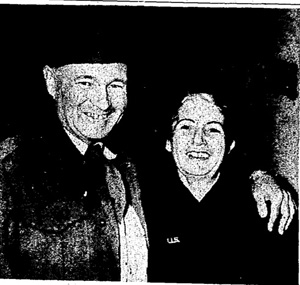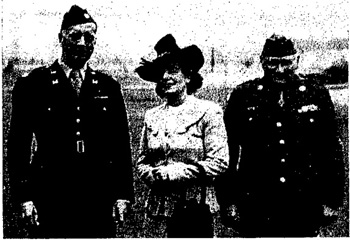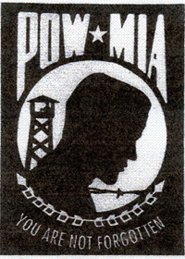MAPLETON MAN IS LIBERATED IN PHILIPPINES
Washington.—(AP)—The War Department Tuesday released the names of two additional Iowa civilians liberated in the Philippines. They were Charles Burton Bradfield, whose mother is Mrs. E. A. Bradfield of Mapleton, and Mary E. Perton, whose next of kin is Anna Mae Perton of Mason City.
Source: The Sioux City Journal, February 21, 1945
![]()

AFTER BEING PRISONER OF JAPS—Sgt. Harry H. Perton and his wife, Mae, whose home is in Mason City, smile broadly on their arrival aboard a transport at Los Angeles, May 2, with more than 2,000 other evacuees from the Philippines. Sgt. Perton was on the death march after being captured by the Japs at Bataan. He spent many unhappy days at Cabanatuan and Bilibid camps. (photo included)
Source: Mason City Globe-Gazette, May 5, 1945
![]()
Wa-Tan-Yes
Hear Story of Prison Camp
Clear Lake—A word picture of the mental torture and slow starvation meted out to American prisoners of war of the Japanese in the Philippines was painted by Mrs. Harry H. Perton, who spent 3 years in Santa Tomas prison before liberation last February.
“The Japs were lenient when they were winning, but the prisoners were made to suffer when they were losing,” she explained. “The first 2 years were bad, but the 3rd was worse.” Mrs. Perton spoke Monday evening to members of Wa-Tan-Yes club, women’s service organization, and guests at the home of Miss Mollie MacGowan.
Mrs. Gerald Brooks arranged the program and introduced Mrs. Perton and her husband, Sgt. Perton, who was a prisoner at Cabanatuan and Bilibid and made the “death march” in which 7,000 prisoners marched 5 days and 5 nights without food or water.
“We were crowded and had no living facilities at first,” Mrs. Perton said. “The only way to have a bath was to use a garden hose, 45 women were assigned to one room, each had a space 39 inches wide. We stood in line for everything. There were details for different work. One detail picked the stones out of the rice, another the worms from other food. We were supposed to get 300 grams of food (cereals) a day but it was cut to 170. Without the help of the Filipinos and the Red Cross rations, we could not have lived. I went from 157 pounds on Jan. 4, 1942 to 86 pounds and my husband, in a different camp, from 215 pound to 110. We were always hungry. We ate chickweed and the stalks of banana plants. When the first American food arrived it consisted of red beans. Everyone became ill because we had not had such hearty food for so long. The happiest days of my life were when my husband found me and when I saw the American flag going up in Manila.”
Sgt. Perton told of his experiences with a vegetable garden and of dealing out pills for the Japs. He has been in the U. S. infantry 18 years before the war broke out and will go to Miami, Fla., before being sent back on duty. Mrs. Perton, Australian born, is not yet a citizen of the United States but she loves the American flag and what it stands for.
Source: Mason City Globe-Gazette, July 17, 1945
![]()
Man, Wife, Jap Prisoners, 3 Years
Tell of Horrors

Above, left to right, are Col. A. T. Lobdell, Mrs. Harry H. Perton, and Sgt. Perton. The Pertons, who were Japanese prisoners-of-war for many months, spoke at the Prisoner-Of-War camp recently in behalf of the bond drive. They also tell Upper Des Moines readers something of what being a Japanese prisoner meant in a story on this page.
Liberation of the Philippines means more to Technical Sergeant Harry H. Perton of the Medical Detachment of the Algona Prisoner of War Camp and his wife than it does to the average resident of Kossuth County.
Both Sergeant and Mrs. Perton experienced more than three years imprisonment in Japanese prisoner of war camps in the Philippines without seeing each other, although at times they were only five blocks apart.
Sergeant Perton, honorably discharged after service in World War I, re-enlisted in the army in 1924, and was sent to the Philippines, attached to the medical department of the 31st Infantry Division.
Sixteen years ago he met his Australian born wife in Manila. They were married. This is the first time she has been in the United States, and when asked how she liked American, Mrs. Perton said, “So far I love it.”
On December 25, 1941, shortly after Pearl Harbor, Sergeant Perton was sent to Bataan. That was the last time he saw his wife until both were liberated in February of this year.
Made Death March
He made the infamous “death march” from Bataan to Camp O’Donnell, a distance of 125 miles, in a forced five day march, going without food or water.
“Our health is all right now,” said the Pertons. They were kept under medical care in the Philippines for two months after their liberation before being permitted to take a ship to the United States.
Sergeant Perton suffered from malaria, dysentery and pneumonia while interned and went from 215 pounds to 110. Mrs. Perton dropped from 157 pounds to 93 pounds.
“During the first two years of interment,” said Perton, “we were given passes to go to a general hospital for examination but as the Americans kept coming closer, the Japs got meaner.”
“We tried to obey the Japanese rules in order to keep out of trouble, though it was hard, and we could not always do so,” Mrs. Perton remarked.
Bayoneted By Guard.
One of the strict rules forbade internees to watch airplanes flying over the Santa Tomas camp where she was imprisoned. “But the daring of the Yanks was marvelous to see,” said Mrs. Perton, “and it was almost impossible to obey that rule. One day a guard came upon me while I was watching our planes. He asked me what I was looking at. I said, “nothing” and at that he struck a bayonet in my side.
Sergeant Perton said he had an idea his wife was at Santa Tomas but was not certain if Mrs. Perton was alive.
“At first civilians were not permitted to write, so it was not until October 1944 that I was able to send word to my husband, more than two years after I was interned at Santa Tomas, January 2, 1942,” said Mrs. Perton.
However, Sergeant Peton had been able to send cards to his wife. But since the cards bore no camp names, only numbers, Mrs. Perton could not tell where her husband was.
The messages were limited to 25 words and those were only words checked off a form card. Only means of identifying the writer was the signature.
Shelled For 12 Days.
In describing the shelling of Santa Tomas for 12 days before liberation, Mrs. Perton said it was inconceivable how, “we could get out of there alive.”
Civilian internees were given 300 grams of cereal a day, Mrs. Perton explained. Sometimes it was rice, sometimes soy beans, at other times corn. “If we asked for more, our rations were cut,” she said. “If we had any vegetables, they came from our own gardens.”
Perton was born and raised at Buffalo Center, son of Mr. and Mrs. Henry H. Perton, now deceased. He graduated from Buffalo Center high in 1915. His wife now lives at Mason City. He had a three-month furlough there before reporting for duty at the Algona Prisoner of War Camp as pharmacist.
What liberation meant to them is best expressed in their own words.
“On February 8, 1945, our Flag was raised. We had waited 37 months for that glorious day. We had seen Old Glory dragged in the streets, torn to pieces and used for scrub rags. There had been tears in our eyes, tears of sorrow from sad hearts.
“On that day in February, there were again tears in our eyes, but this time tears of joy and pride.”
Source: Algona Upper Des Moines, November 8, 1945 (group photo included)
![]()

